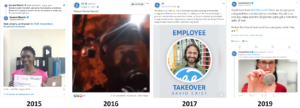Communication Strategy: “A” Is for Audience
Communication Strategy: “A” Is for Audience
Whenever I hear “social media should be real, transparent, and audience focused,” I find myself nodding and wondering at the same time. I agree. It should. But why stop there? All communication should be that way. If it were, it would be way more successful.
Fresh from graduate school, where all I studied was communication—how we humans communicate, what works, what doesn’t—I approached every marcom project as a communication vehicle. My view: it didn’t matter how snappy the writing was or how cool the design looked, if it didn’t resonate with the audience—if it didn’t communicate—the chances of success were slim.
Fast forward 23 years, and the mantra of “real, transparent, and audience focused” is heard everywhere—but mostly just for social media. It’s a start, and I love it. But let’s make it the mantra for all communication.
Know thy audience
It’s not enough to focus on your audience based on your best guess. You need to know your audience:
- Who are they?
- Where are they?
- What do they/don’t they like?
- Why should they care?
- How do they like to interact with you and how can you help them?
I know, “Duh, obvious.” Yet, we don’t always communicate this way. Why? Because we’re most comfortable talking about what we know. And what do we know best? Ourselves. And, of course, there are those who think the best way to sell is to just talk about how great the product or service is, but that’s a topic for another post.
Pick a tool for gathering knowledge about your audience
There are a multitude of ways to learn more about your audience, from traditional to social:
- Query existing and past clients/customers/users (I always love Survey Monkey)
- Ask your social media followers what they think
- Be a “lurker”:
- Find discussion groups and communities in your focus area by doing keyword searches and investigating different sites
- Follow the same process to find other blogs in your focus area
- Conduct similar searches on X (formerly Twitter), LinkedIn, YouTube, Facebook, etc.
- Keep up on your audience’s interests using social media monitoring tools like Facebook Audience Insights, YouTube Insights, Google Trends, etc.
- Conduct old-fashioned market research
Once you’ve done your research, be adaptable and open to feedback and changing any approach that isn’t working. Most importantly, focus on helping your customers. No one wants to be “sold” to or pressured or bombarded with marketing messages. They want information. They want assistance. They want to laugh.
Putting it into practice with your social media audience
I’m sure you’re all thinking, “That’s all well and good, Marie, but what does all of this look like in practice?” And I don’t blame you. As a visual person, I like to see things in action myself. So, here’s one of my favorite case studies: General Electric (GE).
When it comes to a fun, cool company, GE isn’t typically the first company to come to mind unless you follow social media (they’re a popular B2B use case) or you’re a science nerd (guilty as charged). But they’re a great example of how to make social media about the customer and how to build relationships (not to mention telling stories, getting visual, tapping video, and trying new things)—there’s so much goodness coming from them!
I love this quote from GE’s CMO, Linda Boff, in a MarketingWeek article, “Once upon a time we all said ‘content is king,’ then we said ‘distribution is king.’ Really it’s about the user and how we are serving him or her.”

Other good examples are the stories they tell and the conversations they have (all of which build relationships with their audience). That’s actually why GE got into social in the first place—to have conversations. Year over year, they find new ways to tell stories, from tapping into the #LookLikeAnEngineer exchange to employee takeovers to live streaming the Masaya volcano descent.
I’m not advising your social media teams to descend into volcanos, but you get the idea. Tell your own stories. Look at what you’re saying from your audience’s perspective. And make it obvious humans are behind your channels, because whether you’re doing B2C or B2B social media, you’re communicating with people, not buildings.
And really, we humans just want to connect, and we want to be helped, informed, and entertained—which is also a topic for another blog post.





